Until now, Final Fantasy VI has treated Terra as the game’s main character. Even in the brief sequence where you controlled Locke, you didn’t really control him — he made his way through the Narshe caves on auto-pilot, and the entire multi-party battle transpired with Terra unconscious in the background. She’s been a constant presence through the story, but that changes in a big way here and we finally get a true sense of FFVI‘s ensemble cast structure.
The story at this point splits into three, allowing you to follow Terra and Edgar, Locke, or — somewhat surprisingly — newcomer Sabin. Along the way, they katamari themselves some more party members, and by the time the group reconvenes in Narshe your list of available protagonists will nearly have doubled.

Not only is Terra no longer the sole lead for FFVI, her branch of the triple scenario is by far the shortest and least interesting. You head back the way you came, toward Narshe, retracing your footsteps through previously covered ground once again.
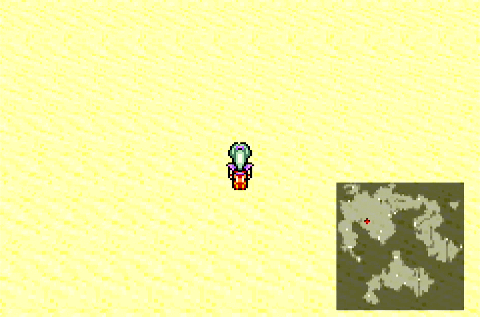
You can wander through familiar ground if you like, but there’s even less point to it than the first time you came through this way: Figaro Castle remains submerged beneath the sands. Edgar must have left his remote in his other pantaloons.

While your goal is Narshe, you can’t enter through the main gate — the guards are still salty about Terra killing off a few dozen of their friends. I suppose the fact that they simply won’t let you into town is them letting you off lightly, all things considered.
You can swap to different lead party members here, but it makes no difference. These guys don’t know Banon, and they understandably assume that Edgar claiming to be the king of Figaro is this world’s equivalent of claiming to be Napoleon Bonaparte.
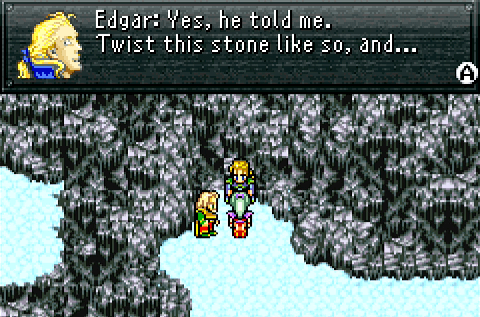
At this point, the game doesn’t explicitly tell you the next step in progressing the plot, instead relying on your ability to remember how things went the first time you were in Narshe. While it’s a bit of a risk to hope you’ll remember Locke’s secret exit from several hours ago and make the connection that it doubles as a secret entrance, the game design doesn’t leave you a lot of other options. There’s really nothing else to do in this region, and it’s clear you need to make your way into the city somehow. The one flaw here is that it hasn’t been possible to activate this secret door until this very moment — so if, for example, you tried poking around with Terra (or even later with Edgar and Locke as well) to re-enter the caves only to find no interactive elements in this cliff, it might not occur to you that suddenly the passage has become available as an option.
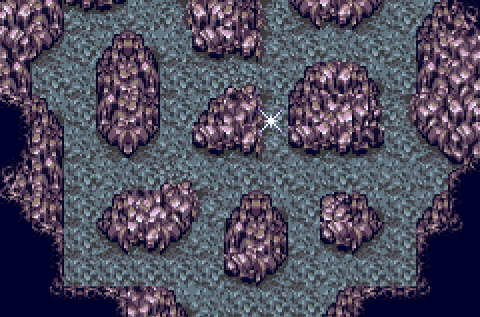
Inside, there’s more retracing of steps, though the game tries to mix it up a little. Here in the large cavern, where you formerly fought a multi-party battles alongside a bunch of moogles, you’ll now find a security system. A light appears and travels along a specific path, which you need to follow precisely lest you trigger a battle and get dumped back to the entrance. This could be interesting, but there’s no discovery here: Edgar straight-up tells you that you need to follow the light. So rather than becoming a puzzle, it’s just a small bit of busywork.
On the other hand, an older RPG would have forced you to figure out the route without the aid of the light, resulting in tedious trial-and-error and massive frustration. Progress isn’t always perfect, but a small chore sure beats a lengthy and tiresome hassle.

The back entrance to Narshe leads you, not surprisingly, to “old man” Arvis’ home, where it all began. And… that’s it for Terra (and Banon, who will make one last cameo or two in the story ahead but never as an active party member). A simple and uninspired diversion that could just as well have been explained in a sentence of narrative.
The other scenarios, on the other hand, are considerably more extensive and imaginative. Of the two, Locke’s is the most compact, so we’ll begin there.
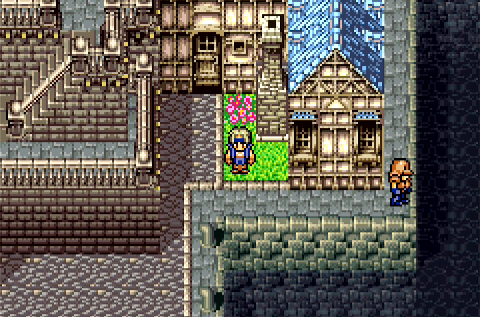
Locke, of course, headed to South Figaro to cause interference with the Empire’s conquest of Figaro, which obviously serves as a foothold for the advance on Narshe and a larger-scale attempt to take the frozen Esper in the caves. He left before the party ventured onto the Lete River, and in a small nod to continuity and timelines, we rejoin him after he’s done his sabotage. Now the task is simply to escape from the city…
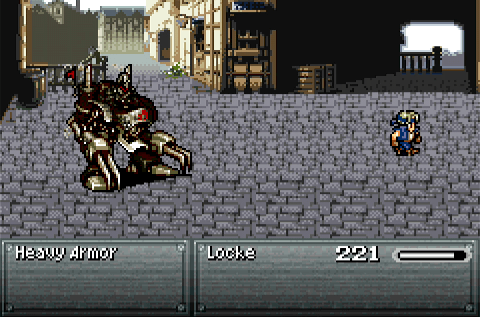
…which is more difficult than it sounds thanks to these advanced Magitek armors stationed about the city at all the exits. Any time Locke talks to a soldier in town, he’ll enter a fight. Regular soldiers he can defeat easily enough, but a Heavy Armor will destroy him in about two turns. With the equipment and items you have at this point in the game, you can’t simply attack and heal your way to victory; you need to spend every turn restoring health, meaning there’s no way to sneak in some damage. While they look like Magitek Armors, which you’ve fought and beaten before, Heavy Armors are far more durable and powerful… though the fact that they’re balanced so as not to kill Locke instantly is a nice touch. If you wander into a fight assuming you can steamroll through, you’re in for a nasty surprise, but you still have time to flee.
For all intents and purposes, though, Heavy Armor is unbeatable at this moment, forcing you to find a more indirect route to the exit.

If you took the time to poke around in South Figaro before, when it was a neutral space, you probably have a good idea of what you’re meant to do: Find the underground passage and sneak out that way. This is more easily said than done, however, as the rich man’s mansion is now under heavy garrison, serving as a makeshift headquarters for the Imperial incursion. This initiates a trading quest of sorts as you need to find your way into the mansion, which involves getting past certain Imperials and a kid blocking the path through town.

This doesn’t seem like much of an obstacle, but this is an RPG. Children are even more indestructible than Heavy Armors.
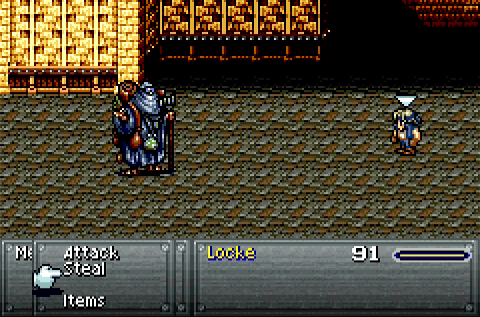
South Figaro has no random encounters, but you can still get into battles with enemy soldiers, Heavy Armors, and… merchants? Yes, it’s possible to fight merchants, which seems pointless at first — they offer little in the way of experience or gold, go down in about two hits, and attack with all the force of the losing contestant in a slap-fight. But if a thief-by-any-other name is going to fight a merchant, wouldn’t you want to see what happens if you try stealing from them? Who knows what kinds of goodies you could pilfer!
The answer, it turns out, is that you can basically steal their best armor (and occasionally their best weapon), the Plumed Hat and the Main Gauche. These are worth having by hook or by crook — especially the Main Gauche, a dagger that increases Locke’s defense (just like a real-world main gauche, which has a special guard that allows for parrying despite its small blade size). But when you steal from a merchant, you also get the bonus of stealing his clothes, leaving him to scurry off in embarrassment… and also in his undercrackers.
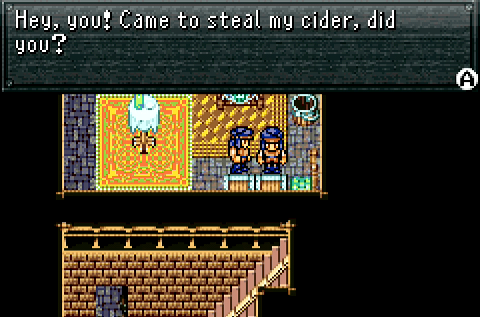
This allows you to get about town as a merchant, which soldiers will give you passage to areas that Locke couldn’t reach. However, you’re pointed toward one specific merchant, who carries a special stock of cider, which is mentioned conspicuously by an old man who in turn is mentioned conspicuously as a means of gaining access to the north mansion. If you approach this merchant while disguised as a competitor, he’ll go on the attack, allowing you to acquire the all-important cider.
You can also use the steal trick on green-garbed soldiers, which allows you to swipe their uniform and relieve certain soldiers at key points in the city. You still can’t slip past the Heavy Armor, but getting about in disguise is generally the way to go here.
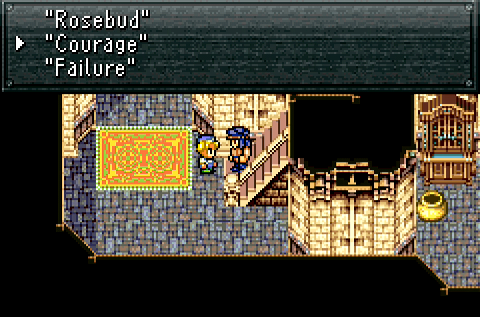
Once you have the cider, you give it to the old man, who… does nothing for you. Weirdly, the game drops you into a guessing game, since the old drunk forgot the password to get through town. Still, this does open up a dialogue prompt with the kid obstructing the stairway that leads to the back part of town and the mansion’s service entrance, which is the real point. But you have to take a wild guess at the password to get through. Though there’s no penalty for failure, so again, this is one of those instances where FFVI puts up a semblance of complexity without really delivering.
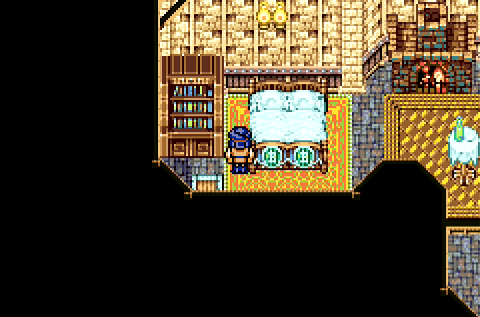
Inside the mansion, however, there’s a nice touch of sound design. Duncan’s wife, who lives in the city, mentions that there are secrets where draught excluders don’t live, and it’s pretty easy to put together two and two and deduce that you need to look for a secret passage in a drafty room. When you enter the rich man’s study, the game music fades away — conspicuously, as this is the first time in this South Figaro sequence that the background melody has disappeared entirely — and as you approach the bookshelves in the west end of the room you begin to hear wind noises fade up. While a bit of an exaggeration, it’s a clever use of audio to create a clue while still allowing the player to draw his or her own conclusions.
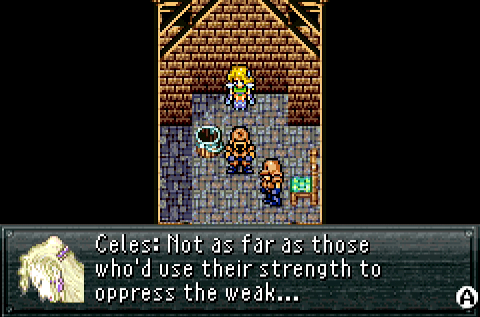
Behind the bookshelf is a cellar that’s been turned into a makeshift cell: A woman has been locked up here by Imperial soldiers. You can name her if you like, which obviously means she’s about to team up with Locke…
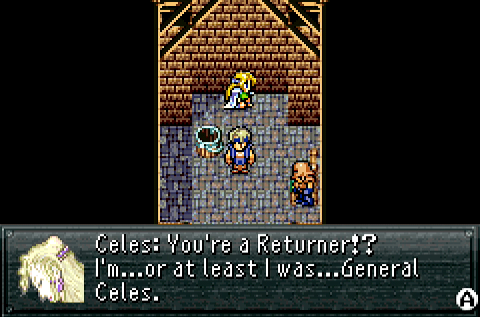
…despite ostensibly operating on the other side of the law. Locke and Celes (or Han and Leia, if you prefer) have a lengthy conversation right in front of a sleeping guard before making a hasty exit through the cellars.

You’ll find an even more secret passage leading forward if you wind the broken clock. If you spoke to the rich man’s daughter, there was a clue here… though the game won’t let you out the other way, and this is a dead end, so it’s not like you have a lot of other choices here.
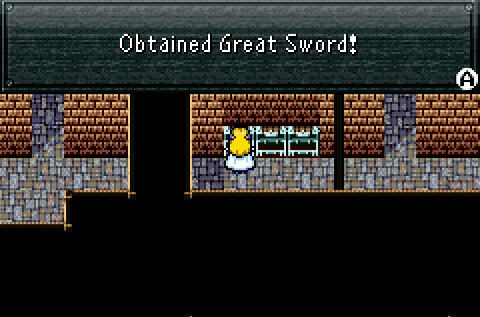
In a nice little touch, the treasure chests in the hidden passage appear to contain Celes’ armor and weapons, which the Empire obviously stripped from her when she was put into prison for being insufficiently horrible.

The so-called secret passage also plays home to a lot of soldiers and guard dogs, making this one horribly-kept secret. However, the combat sequence here does allow you the chance to get a sense of Celes’ capabilities… sort of. Like Terra, she can use magic — her specialty is ice versus Terra’s innate fire skills. Once again, this serves to highlight Terra’s uniqueness; Celes is one of the few humans capable of casting magic, and she was installed as a high-ranking soldier in the Empire as a result. None of the mooks you take on here can use spells. At this point, Locke has become best pals with the two most powerful ladies on the planet in the space of a few days.
Unlike Terra, Celes also has a special command unique to her class (Runic Knight) to complement her spellcasting: Runic. At this point, however, Runic appears to do nothing whatsoever besides wasting a turn. This is actually true of most of the game! But Celes’ unique skill does have its uses and will come into play soon enough.
Unlike a certain later barrier, the Heavy Armors can be defeated. It’s just that it’s hard to do and even if you kill one the armor itself still blocks your way.